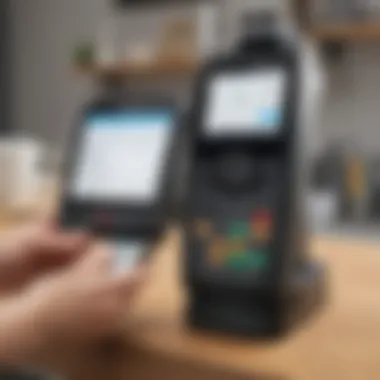Understanding the Spot POS System for Businesses


Intro
The Spot POS system has increasingly become an essential instrument for a range of businesses focused on optimizing their workflows and enhancing customer satisfaction. In an age where transaction speed and accuracy are critical, this system stands out due to its various capabilities. This guide aims to dissect the features of the Spot POS system, evaluate its performance, and address how it can be adapted to meet unique business requirements.
Understanding the functionalities of Point of Sale systems is crucial for entrepreneurs and IT professionals alike. Choosing the right software can significantly influence operational efficiency. This article will delve into the core functionalities, pros and cons, and performance metrics of the Spot POS system. By presenting a comprehensive analysis, readers can better assess how this tool aligns with their specific objectives.
Key Features of the Software
The Spot POS system offers a suite of features designed to meet the demands of small to medium-sized businesses. Its design emphasizes usability, which makes it accessible for users with varying levels of experience.
Overview of Core Functionalities
- Sales Tracking: Spot POS enables real-time sales tracking, providing business owners insights into their performance metrics.
- Inventory Management: This feature allows businesses to maintain optimal stock levels, reducing wastage and minimizing lost sales due to stockouts.
- Customer Management: The system includes customer profile management, helping businesses tailor their services to meet individual customer needs effectively.
- Reporting and Analytics: Spot POS generates detailed reports that help businesses understand their financial health and identify areas for improvement.
- Integration Capabilities: The system integrates seamlessly with various accounting and e-commerce platforms, streamlining various business processes.
Unique Selling Points
- User-Friendly Interface: The intuitive design of Spot POS ensures that employees can quickly learn how to operate the system.
- Flexibility: Spot POS can be customized according to the specific needs of different industries, making it suitable for various business models.
- Affordable Pricing: Compared to other solutions on the market, Spot POS provides competitive pricing that appeals to businesses with limited budgets.
"The Spot POS system not only simplifies transactions but offers valuable insights that can drive smarter business decisions."
In-Depth Software Analysis
A thorough evaluation of the Spot POS system reveals both its strengths and limitations. Understanding these aspects will help businesses determine if this software fits their operational needs.
Pros and Cons
Pros:
- Ease of Use: Users report that the system is straightforward to navigate, reducing training time.
- Robust Customer Support: Spot POS offers dedicated support, ensuring that users can resolve any issues that arise promptly.
Cons:
- Limited Customization Options: Some users find the customization of features to be somewhat restricted compared to larger systems.
- Initial Setup Complexity: Setting up the system can be time-consuming, requiring collaboration with IT professionals for optimal configuration.
Performance Metrics
Businesses consider various performance metrics when evaluating a POS system, including:
- Speed of Transactions: Quick processing times enhance customer experience at checkout.
- System Reliability: Any downtime can affect sales and customer satisfaction. Spot POS aims for high uptime rates.
- Scalability: As a business grows, the capabilities of Spot POS should expand without significant additional investment.
By examining these core features, pros and cons, and performance benchmarks, businesses can make an informed decision about implementing the Spot POS system. This guide will continue to explore integration strategies and affordability considerations, enabling users to harness the full potential of Spot POS.
Preface to Spot POS System
The Spot POS system has become integral to businesses aiming to streamline operations while enhancing customer engagement. Understanding this system is essential for decision-makers who want to improve their transaction processes and overall efficiency. As the business landscape evolves, traditional sales methods are no longer sufficient. The integration of technology in point-of-sale systems reflects this change, providing numerous benefits and driving the necessity for businesses to adapt.
Definition and Overview
The Spot POS (Point of Sale) system is a software and hardware solution that facilitates retail transactions. Its primary function is to process sales, manage inventory, and maintain financial reporting capabilities. Typically, it includes the following components:
- Hardware: This can involve a cash register, barcode scanner, receipt printer, and card reader.
- Software: The program that enables all these components to work together effectively.
Sophisticated Spot POS systems allow businesses to merge sales and customer data in real-time, promoting better decision-making and financial insights. Additionally, this system is often cloud-based, granting access to data from any location with internet connectivity.
Importance in Modern Business
In modern business, the Spot POS system is not merely a tool for processing sales. Its importance can be assessed through several lenses:
- Efficiency: Automated processes reduce human error and accelerate transaction times, leading to better service for customers.
- Data Analysis: With real-time reporting abilities, businesses can track sales trends, customer behaviors, and stock levels efficiently.
- Scalability: As businesses grow, the Spot POS can adapt, accommodating additional features or hardware as needed.
"The Spot POS system enables businesses to capture valuable data that enhances operational decision-making and customer satisfaction."
Ultimately, understanding the Spot POS system is not just about recognizing its features and benefits. It requires businesses to explore the strategic implications of its adoption, weighing the investment against potential return and operational improvement.


Key Features of the Spot POS System
The Spot POS system is designed with several key features that address the diverse needs of modern businesses. Understanding these features is essential for entrepreneurs and IT professionals who are considering an implementation. These elements contribute to the system's effectiveness in enhancing efficiency and ensuring customer satisfaction.
User-Friendly Interface
One of the standout features of the Spot POS system is its user-friendly interface. A smooth and intuitive interface can significantly decrease the learning curve for employees while improving operational efficiency. Staff members can navigate the system with ease, allowing them to focus more on customer service rather than struggling with complicated technology. Quick access buttons and straightforward menus play a crucial role in this ease of use, making training for new employees less time-consuming. By reducing barriers associated with technology, the Spot POS system fosters a productive environment that encourages staff to engage more meaningfully with customers.
Inventory Management Capabilities
Effective inventory management is critical for any business that sells physical products. Spot POS offers robust inventory management capabilities, allowing businesses to track stock levels, manage orders, and set reorder alerts. Real-time inventory tracking helps prevent stockouts, which can result in lost sales. With organized inventory data, businesses can analyze their product performance and make informed decisions regarding which items need more promotion or restocking. This not only enhances operational efficiency but also improves profitability by minimizing excess inventory and optimizing turnover.
Sales Reporting and Analytics
Another significant feature of the Spot POS system is its sales reporting and analytics capabilities. These tools provide businesses with actionable insights into sales trends, peak shopping times, and customer purchasing behavior. Through detailed reports, businesses can identify the most popular products, which helps in planning marketing strategies and promotions effectively. The analytics feature enables businesses to forecast future sales and allocate resources accordingly. In today's competitive market, having data-driven insights can be a game-changer for strategic planning and operational management.
Customer Relationship Management Tools
Customer relationship management (CRM) tools integrated within the Spot POS system are vital for nurturing customer relationships. These tools allow businesses to gather customer data, track purchase history, and create targeted marketing campaigns. By understanding customer preferences and behavior, businesses can offer personalized experiences, which significantly enhance customer loyalty. CRM features enable businesses to engage with customers through loyalty programs, rewards, and special offers tailored to individual buying habits. Better customer relationships lead to repeat business, ultimately contributing to long-term profitability.
Benefits of Implementing Spot POS
Implementing the Spot POS system can bring significant advantages for businesses, particularly for small to medium-sized enterprises. As companies strive to enhance their operational efficiency and customer satisfaction, adopting innovative technology like Spot POS is essential in today's competitive market. This section elaborates on key benefits that can be leveraged by integrating this type of point-of-sale solution.
Improved Transaction Speed
One of the most notable benefits of the Spot POS system is improved transaction speed. In a fast-paced business environment, customers expect quick service. Delays during checkout can lead to dissatisfaction and even loss of business. Spot POS uses advanced technology to process transactions rapidly. This efficiency often translates to shorter lines and increased customer throughput.
Moreover, features such as contactless payment options speed up checkout further. Customers can make payments with a simple tap of their cards or smartphones. In turn, businesses can handle higher volumes of sales without overburdening their staff. This improvement in transaction speed helps create a more fluid shopping experience, ultimately enhancing customer satisfaction.
Enhanced Customer Experience
Spot POS not only benefits the business but also significantly improves customer experience. With an easy-to-navigate interface, staff can access necessary information quickly. This capability allows employees to answer customer inquiries efficiently and address any issues that may arise. A smooth, engaging transaction process supports positive interactions.
Additionally, integrating customer relationship management (CRM) tools within Spot POS allows businesses to capture vital customer data. Such data is invaluable for personalizing service and offers. For example, knowing a customer's previous purchases can help suggest relevant products. This tailored approach can enhance customer loyalty and increase repeat business. When customers feel valued and respected, they are more likely to return and recommend the business to others.
Cost Efficiency and Profitability
Cost efficiency is another critical aspect where Spot POS shines. By automating various processes, businesses can reduce the manual workload and minimize errors. This automation can lead to cost savings in labor and operational expenses. Furthermore, efficient inventory management helps to reduce wastage and improve stock turnover rates. Less capital is tied up in unsold inventory, allowing businesses to allocate resources better.
Additionally, insightful sales reporting and analytics help decision-makers understand trends and customer behavior. These insights enable businesses to adjust strategies promptly, optimizing pricing or promotions to maximize profits. Ultimately, implementing the Spot POS system can be a strategic investment, enhancing both profitability and long-term sustainability for businesses.
"The Spot POS system is more than just a cash register; it is a comprehensive tool that drives efficiency and enhances customer interactions."
By embracing the Spot POS system, businesses position themselves to thrive in an ever-evolving marketplace. The cumulative impact of improved transaction speed, enhanced customer experience, and cost efficiency creates a strong foundation for sustained growth and success.
Integrating Spot POS with Other Systems
Integrating the Spot POS system with other platforms is critical for businesses to maximize their operational efficiency. This integration allows seamless data flow between different systems, ensuring that all business tools work together effectively. When businesses utilize various software solutions, the ability to connect these tools can greatly enhance data accuracy and reduce redundancy.
Compatibility with Accounting Software
Compatibility with accounting software is a pivotal aspect when implementing the Spot POS system. Businesses often rely on accounting software to track financial health, manage invoicing, and oversee expenditures. When Spot POS can synchronize with these accounting tools, it minimizes the chances of errors typically encountered when transferring data manually.
With this integration, sales data recorded on the Spot POS system can be automatically updated in the accounting software. This streamlined process not only saves time but also allows for more accurate financial reporting. Some popular accounting systems that can integrate include QuickBooks and Xero. Having real-time data reflected in accounting software provides businesses with immediate access to crucial financial metrics, aiding in informed decision-making.
- Benefits:
- Real-time financial reporting
- Reduced data entry errors
- Time savings in financial management
Linking with E-commerce Platforms
Linking the Spot POS system with e-commerce platforms is equally important in today’s digital marketplace. As online sales transactions grow, the need for a cohesive system that manages both in-store and online sales becomes essential. Through integration with e-commerce platforms like Shopify or WooCommerce, businesses can track inventory across all sales channels without discrepancies.


This connection helps in aligning sales data, ensuring that product availability is always current. When an item is sold in-store, inventory levels are automatically updated across online platforms. This reduces the risk of overselling and improves customer satisfaction, as clients will always know product availability. Moreover, integrated sales statistics can provide insights that drive marketing strategies and inventory management.
- Benefits:
- Unified inventory management
- Accurate sales reporting across channels
- Enhanced customer satisfaction
Integrating the Spot POS system with other essential business tools leads to improved accuracy and real-time insights, benefiting overall operations.
Cost Considerations for Spot POS
When selecting a Point of Sale (POS) system for a business, understanding cost considerations is crucial. The Spot POS system, along with its capabilities, can come with various initial and ongoing costs. These financial aspects can significantly affect the overall value and return on investment for small to medium-sized businesses.
Being aware of cost factors ensures a well-informed decision. Expenses related to both setup and subscription influence the bottom line of a business. Additionally, these factors must be weighed against the potential efficiency gains and customer satisfaction improvements that the Spot POS can provide. Thus, comprehending these financial elements is vital for any entrepreneur looking to adopt modern POS technology.
Initial Setup Costs
The initial setup costs for the Spot POS system can vary significantly based on the specific requirements of a business. This typically includes hardware expenses, software licensing fees, and possibly installation services.
- Hardware Expenses:
- Software Licensing Fees:
- Installation Services:
- The basic hardware setup may include POS terminals, receipt printers, and cash drawers. Each item adds to the total expense.
- Companies might also need bar code scanners and payment processing devices. Choosing the right brand and specifications can influence cost.
- Spot POS often has software fees associated with it. These can be one-time purchases or require annual renewals.
- Additional features or customizations may incur extra costs.
- Depending on the complexity, businesses might need professional installation. This can add to the initial costs, especially for companies with multiple locations.
For a complete understanding, businesses should create a detailed budget that forecasts these potential upfront investments.
Monthly Subscription Fees
After the initial investment, the monthly subscription fees can be a significant part of operating costs. Most modern POS systems, including Spot POS, leverage subscription-based models, which offer both advantages and disadvantages.
- Recurring Costs:
- Scalability Considerations:
- Payment Processing Fees:
- Most likely, businesses will encounter fees for software access, updates, and support. This can ensure ongoing improvements and security.
- As businesses grow, additional fees may be necessary. More users or advanced features may lead to escalated costs.
- If integrated with payment processors, transaction fees should not be neglected. These can accumulate over time, impacting profitability.
Always consider these ongoing costs when planning your budget. They can add significantly to your overall expense structure.
Understanding these financial elements allows a clear view of the true cost of operating the Spot POS system. A meticulous evaluation will prepare businesses for both the immediate and long-term financial commitments involved with adopting this technology.
Spot POS System in Different Industries
The adaptability of the Spot POS system across various industries underscores its significance in modern business operations. Different sectors benefit uniquely from this technology, enhancing specific functionalities that address their individual challenges. Understanding these diverse applications is crucial for business owners and entrepreneurs looking to optimize their processes and improve customer interactions.
Retail Sector Applications
In the retail world, the Spot POS system shines as a method to improve transaction efficiency and manage inventory with ease. Retailers can access real-time data about stock levels, ensuring that popular items do not run out. Furthermore, with built-in sales analytics, businesses can identify trends in purchasing behavior. This data can inform marketing strategies and product placements, making inventory management more insightful.
Employees benefit from a streamlined checkout process that minimizes waiting times. Additionally, the system often integrates seamlessly with customer loyalty programs, enabling retailers to build better relationships with shoppers while analyzing spending patterns.
Hospitality Industry Uses
For the hospitality industry, including restaurants and hotels, the Spot POS system is indispensable. It supports order management and enables quick payments, enhancing the overall customer experience. Staff can easily track orders from the table to the kitchen, thereby reducing errors and improving communication.
Moreover, hospitality businesses can benefit from features like tableside payment processing. This convenience can lead to faster meal turnover, greater customer satisfaction, and ultimately, increased revenue. The system can also assist in managing bookings and reservations, further streamlining operations.
Service-Oriented Businesses
Service-oriented businesses, such as spas or salons, also gain significant advantages from the Spot POS system. These establishments can track appointments efficiently, manage customer databases, and handle payments all in one platform. The integration of a calendar feature allows for effective scheduling, minimizing no-shows and maximizing customer capacity.


In addition, these businesses can offer upselling opportunities directly through the system. For example, a salon can suggest additional treatments at the point of sale, increasing the average transaction value. With such tailored solutions, service-oriented firms can enhance both client satisfaction and profitability.
The Spot POS system's versatility in various industries makes it a valuable investment for businesses aiming to improve efficiency and customer relations.
Challenges of Using Spot POS
While the Spot POS system offers numerous advantages, it also presents challenges that businesses need to consider. Understanding these challenges is crucial for small to medium-sized enterprises when deciding whether to adopt this technology. Here, we will outline two primary challenges: technical support issues and training requirements for staff.
Technical Support Issues
One of the prominent challenges with the Spot POS system involves technical support. Although the system is designed to be user-friendly, technical problems can arise. These issues may range from software glitches to hardware malfunctions. When businesses encounter such problems, they often rely on technical support for resolution.
The quality and responsiveness of technical support can significantly impact a business's operational efficiency. Delays in addressing support requests can lead to downtime, affecting sales and customer service. Therefore, it's essential to review the technical support options before selecting Spot POS. Knowing the availability of support services, such as response times and whether support is offered 24/7, can be beneficial in minimizing potential disruptions.
Moreover, some users report difficulties in reaching knowledgeable support personnel. If a business lacks direct access to expert help, it could face extended periods of inoperability. This situation can create frustration when transactions are disrupted. As a result, assessing the reliability of technical support is a critical element for businesses when implementing the Spot POS system.
Training Requirements for Staff
Another challenge to consider is the training requirements for staff. Although Spot POS is designed for ease of use, effective implementation necessitates adequate training. Employees need to become familiar with the system’s features to utilize it fully. Insufficient training can lead to operational inefficiencies and errors in transaction processing.
Training sessions should cover all aspects of the system, including inventory management, sales reporting, and customer interaction features. The time and resources spent on training can vary based on the size of the business and the number of employees impacted. In addition, ongoing training may be required as system updates or new features are introduced.
Establishing a comprehensive training program is necessary. This ensures that all employees not only understand how to operate the system but can also troubleshoot basic issues. Organizations must consider the potential costs of training, including the possibility of hiring external consultants if expertise is lacking internally.
Investing in training can lead to better staff performance, reducing errors and improving customer interactions.
By addressing both the technical support challenges and staff training requirements, businesses can better prepare for the implementation of the Spot POS system. Recognizing these hurdles allows for strategic planning, thus enabling a smoother transition and more effective usage of the system long term.
Future of Spot POS Technology
The evolution of technology continually reshapes how businesses operate. Within this dynamic context, understanding the future of the Spot POS system is crucial for stakeholders. The trends in point of sale solutions reflect changes in consumer behavior and technological advances. The significance of these trends extends beyond mere adaptations; they inform strategic decisions that can enhance operational efficiency.
Trends in Point of Sale Solutions
Several trends are currently transforming point of sale solutions. First, cloud-based systems are becoming increasingly popular. This shift allows businesses to access their data from anywhere, enhancing flexibility. Second, the rise of mobile payment options caters to a growing demand for speed and convenience. Customers prefer using their smartphones for transactions, and businesses that adapt to this trend stand to benefit greatly.
Another trend is the integration of artificial intelligence into POS systems. AI offers predictive analytics, helping businesses understand consumer behavior better. Recognizing buying patterns can lead to tailored marketing strategies. Furthermore, contactless payments are gaining traction, especially following recent health concerns. Security is an essential aspect; hence, incorporating advanced encryption methods will continue gaining importance as data privacy becomes a focal point.
Predicted Developments in Features
Future developments in the Spot POS system will likely center around customization and personalization. As businesses realize that every industry has unique needs, customizable features will allow them to tailor the system according to their specific requirements. Enhanced analytics tools are also expected to be featured prominently. With better data collection and analysis capabilities, businesses can make informed decisions regarding inventory, staffing, and marketing strategies.
Moreover, integration with e-commerce will become a standard expectation. As online shopping grows, seamless connectivity between online and offline sales channels is essential. This development eliminates discrepancies and maintains consistency in customer experience.
Finally, sustainability will likely influence future POS technology. As businesses focus on social responsibility, environmentally-friendly practices in hardware and software will become more common. The emphasis on energy-efficient solutions reflects broader societal values and can enhance a brand's reputation.
"Adapting to the changing landscape of POS technology is not just about innovation; it's about survival in a competitive market."
In summary, the future of the Spot POS system holds promise, driven by technological advancements and changing consumer expectations. Businesses that embrace these changes will likely improve operational efficiency and customer satisfaction.
Finale
The conclusion holds significant value in this article as it synthesizes the various elements discussed throughout. Understanding the Spot POS system is crucial for businesses that aim to optimize their operations and improve customer interactions. This section emphasizes how the features and benefits of Spot POS intertwine to form a comprehensive solution for small to medium-sized businesses, entrepreneurs, and IT professionals.
Summary of Insights
This article has explored the multiple dimensions of the Spot POS system. Key insights include:
- User-friendly interface: The design caters to users of all technical levels, enabling swift adoption.
- Integration capabilities: Spot POS can seamlessly connect with accounting software and e-commerce platforms, making it a versatile tool for various business models.
- Cost efficiency: Although initial setup costs need consideration, ongoing benefits such as improved transaction speeds and enhanced customer experiences translate to long-term profitability.
- Industry applications: The system serves diverse sectors, from retail to hospitality, indicating its adaptability.
Thus, the Spot POS system emerges not only as a tool for conducting transactions but also as a strategic asset that enhances operational efficiency and customer relationship management.
Making an Informed Decision
As businesses evaluate Point of Sale solutions, informed decision-making is vital. The following factors should be considered:
- Needs assessment: Determine specific business requirements that the Spot POS system can fulfill.
- Cost-benefit analysis: Analyze initial investment against potential long-term savings and revenue increases.
- Scalability: Ensure that the Spot POS system can grow alongside the business, adapting as demands change.
- Support and Training: Investigate technical support and training resources available to ensure successful implementation.
By reflecting on these considerations, decision-makers will be better equipped to select the appropriate system that aligns with their business goals.















